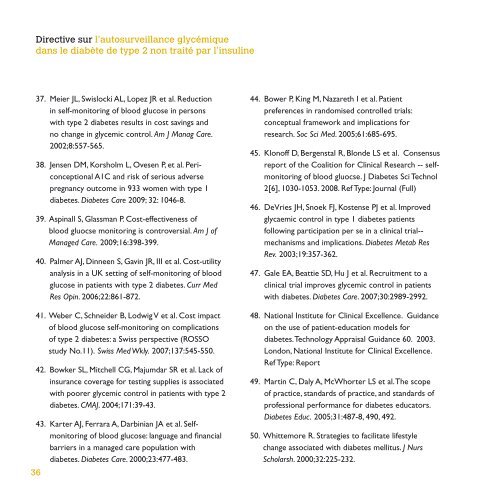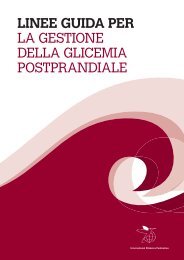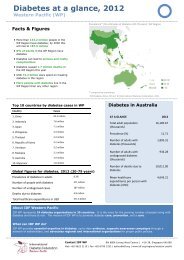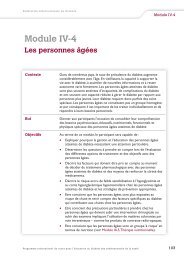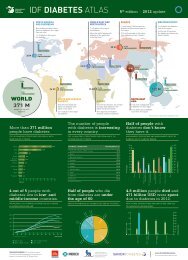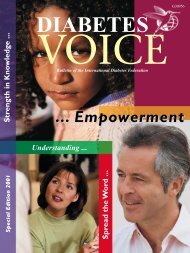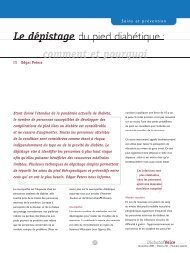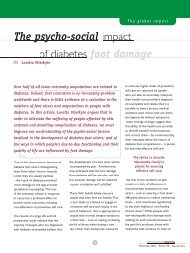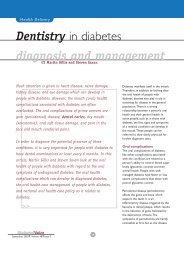Autosurveillance - International Diabetes Federation
Autosurveillance - International Diabetes Federation
Autosurveillance - International Diabetes Federation
You also want an ePaper? Increase the reach of your titles
YUMPU automatically turns print PDFs into web optimized ePapers that Google loves.
Directive sur l’autosurveillance glycémique<br />
dans le diabète de type 2 non traité par l’insuline<br />
37. Meier JL, Swislocki AL, Lopez JR et al. Reduction<br />
in self-monitoring of blood glucose in persons<br />
with type 2 diabetes results in cost savings and<br />
no change in glycemic control. Am J Manag Care.<br />
2002;8:557-565.<br />
38. Jensen DM, Korsholm L, Ovesen P, et al. Periconceptional<br />
A1C and risk of serious adverse<br />
pregnancy outcome in 933 women with type 1<br />
diabetes. <strong>Diabetes</strong> Care 2009; 32: 1046-8.<br />
39. Aspinall S, Glassman P. Cost-effectiveness of<br />
blood gluocse monitoring is controversial. Am J of<br />
Managed Care. 2009;16:398-399.<br />
40. Palmer AJ, Dinneen S, Gavin JR, III et al. Cost-utility<br />
analysis in a UK setting of self-monitoring of blood<br />
glucose in patients with type 2 diabetes. Curr Med<br />
Res Opin. 2006;22:861-872.<br />
41. Weber C, Schneider B, Lodwig V et al. Cost impact<br />
of blood glucose self-monitoring on complications<br />
of type 2 diabetes: a Swiss perspective (ROSSO<br />
study No.11). Swiss Med Wkly. 2007;137:545-550.<br />
42. Bowker SL, Mitchell CG, Majumdar SR et al. Lack of<br />
insurance coverage for testing supplies is associated<br />
with poorer glycemic control in patients with type 2<br />
diabetes. CMAJ. 2004;171:39-43.<br />
43. Karter AJ, Ferrara A, Darbinian JA et al. Selfmonitoring<br />
of blood glucose: language and financial<br />
barriers in a managed care population with<br />
diabetes. <strong>Diabetes</strong> Care. 2000;23:477-483.<br />
36<br />
44. Bower P, King M, Nazareth I et al. Patient<br />
preferences in randomised controlled trials:<br />
conceptual framework and implications for<br />
research. Soc Sci Med. 2005;61:685-695.<br />
45. Klonoff D, Bergenstal R, Blonde LS et al. Consensus<br />
report of the Coalition for Clinical Research -- selfmonitoring<br />
of blood gluocse. J <strong>Diabetes</strong> Sci Technol<br />
2[6], 1030-1053. 2008. Ref Type: Journal (Full)<br />
46. DeVries JH, Snoek FJ, Kostense PJ et al. Improved<br />
glycaemic control in type 1 diabetes patients<br />
following participation per se in a clinical trial--<br />
mechanisms and implications. <strong>Diabetes</strong> Metab Res<br />
Rev. 2003;19:357-362.<br />
47. Gale EA, Beattie SD, Hu J et al. Recruitment to a<br />
clinical trial improves glycemic control in patients<br />
with diabetes. <strong>Diabetes</strong> Care. 2007;30:2989-2992.<br />
48. National Institute for Clinical Excellence. Guidance<br />
on the use of patient-education models for<br />
diabetes. Technology Appraisal Guidance 60. 2003.<br />
London, National Institute for Clinical Excellence.<br />
Ref Type: Report<br />
49. Martin C, Daly A, McWhorter LS et al. The scope<br />
of practice, standards of practice, and standards of<br />
professional performance for diabetes educators.<br />
<strong>Diabetes</strong> Educ. 2005;31:487-8, 490, 492.<br />
50. Whittemore R. Strategies to facilitate lifestyle<br />
change associated with diabetes mellitus. J Nurs<br />
Scholarsh. 2000;32:225-232.


